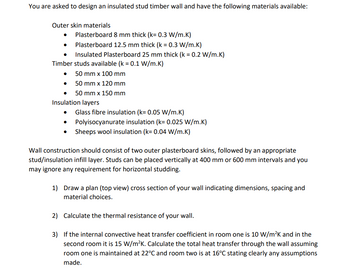
Elements Of Electromagnetics
7th Edition
ISBN: 9780190698614
Author: Sadiku, Matthew N. O.
Publisher: Oxford University Press
expand_more
expand_more
format_list_bulleted
Concept explainers
Question

Transcribed Image Text:You are asked to design an insulated stud timber wall and have the following materials available:
Outer skin materials.
●
Plasterboard 8 mm thick (k= 0.3 W/m.K)
Plasterboard 12.5 mm thick (k = 0.3 W/m.K)
Insulated Plasterboard 25 mm thick (k = 0.2 W/m.K)
Timber studs available (k = 0.1 W/m.K)
50 mm x 100 mm
50 mm x 120 mm
50 mm x 150 mm
Insulation layers
Glass fibre insulation (k= 0.05 W/m.K)
● Polyisocyanurate insulation (k= 0.025 W/m.K)
Sheeps wool insulation (k= 0.04 W/m.K)
●
Wall construction should consist of two outer plasterboard skins, followed by an appropriate
stud/insulation infill layer. Studs can be placed vertically at 400 mm or 600 mm intervals and you
may ignore any requirement for horizontal studding.
1) Draw a plan (top view) cross section of your wall indicating dimensions, spacing and
material choices.
2) Calculate the thermal resistance of your wall.
3) If the internal convective heat transfer coefficient in room one is 10 W/m²K and in the
second room it is 15 W/m²K. Calculate the total heat transfer through the wall assuming
room one is maintained at 22°C and room two is at 16°C stating clearly any assumptions
made.
Expert Solution
This question has been solved!
Explore an expertly crafted, step-by-step solution for a thorough understanding of key concepts.
Step by stepSolved in 4 steps with 8 images

Knowledge Booster
Learn more about
Need a deep-dive on the concept behind this application? Look no further. Learn more about this topic, mechanical-engineering and related others by exploring similar questions and additional content below.Similar questions
- c. Determine critical load and critical stress for the column/axial member. Justify selection of the formulas for the calculationsInformation provided: i) Boundary/end conditions: In this instance, the column is assumed to be fixed at both ends, simulating conditions where the column is integrally connected to the floor slabs above and below, a common condition in many mechanical design contexts. ii) External axial load: Assuming the column supports a floor with a uniformly distributed load, we've calculated the total axial load on the column to be 453.589 kN. iii) Properties of the column: The cylindrical column is composed of steel, a commonly used material with a known Young's modulus (E) of approximately 200 GPa. The steel has a yield stress of around 250 MPa and ultimate stress near 400 MPa. The diameter (d) of the column is 0.3048 m, providing a cross-sectional area (A) of π*(d/2)² = 0.073 m².arrow_forwardC A cantilever beam is subjected to a downward force of 5 kN at its free end, as shown in Fig. 1. The beam is supported by a circular bracket (BD) attached to a wall. The bracket is made of ductile steel whose elastic limit is 300 MPa, both in tension and compression. Determine the diameter of supporting post using Von-Mises theory. (Hint: Neglected the weight of the beam, the ends B and D are welded) Fig.3 3 m B 2 m 2 m 2 m 5 kNarrow_forward
Recommended textbooks for you
 Elements Of ElectromagneticsMechanical EngineeringISBN:9780190698614Author:Sadiku, Matthew N. O.Publisher:Oxford University Press
Elements Of ElectromagneticsMechanical EngineeringISBN:9780190698614Author:Sadiku, Matthew N. O.Publisher:Oxford University Press Mechanics of Materials (10th Edition)Mechanical EngineeringISBN:9780134319650Author:Russell C. HibbelerPublisher:PEARSON
Mechanics of Materials (10th Edition)Mechanical EngineeringISBN:9780134319650Author:Russell C. HibbelerPublisher:PEARSON Thermodynamics: An Engineering ApproachMechanical EngineeringISBN:9781259822674Author:Yunus A. Cengel Dr., Michael A. BolesPublisher:McGraw-Hill Education
Thermodynamics: An Engineering ApproachMechanical EngineeringISBN:9781259822674Author:Yunus A. Cengel Dr., Michael A. BolesPublisher:McGraw-Hill Education Control Systems EngineeringMechanical EngineeringISBN:9781118170519Author:Norman S. NisePublisher:WILEY
Control Systems EngineeringMechanical EngineeringISBN:9781118170519Author:Norman S. NisePublisher:WILEY Mechanics of Materials (MindTap Course List)Mechanical EngineeringISBN:9781337093347Author:Barry J. Goodno, James M. GerePublisher:Cengage Learning
Mechanics of Materials (MindTap Course List)Mechanical EngineeringISBN:9781337093347Author:Barry J. Goodno, James M. GerePublisher:Cengage Learning Engineering Mechanics: StaticsMechanical EngineeringISBN:9781118807330Author:James L. Meriam, L. G. Kraige, J. N. BoltonPublisher:WILEY
Engineering Mechanics: StaticsMechanical EngineeringISBN:9781118807330Author:James L. Meriam, L. G. Kraige, J. N. BoltonPublisher:WILEY

Elements Of Electromagnetics
Mechanical Engineering
ISBN:9780190698614
Author:Sadiku, Matthew N. O.
Publisher:Oxford University Press

Mechanics of Materials (10th Edition)
Mechanical Engineering
ISBN:9780134319650
Author:Russell C. Hibbeler
Publisher:PEARSON

Thermodynamics: An Engineering Approach
Mechanical Engineering
ISBN:9781259822674
Author:Yunus A. Cengel Dr., Michael A. Boles
Publisher:McGraw-Hill Education

Control Systems Engineering
Mechanical Engineering
ISBN:9781118170519
Author:Norman S. Nise
Publisher:WILEY

Mechanics of Materials (MindTap Course List)
Mechanical Engineering
ISBN:9781337093347
Author:Barry J. Goodno, James M. Gere
Publisher:Cengage Learning

Engineering Mechanics: Statics
Mechanical Engineering
ISBN:9781118807330
Author:James L. Meriam, L. G. Kraige, J. N. Bolton
Publisher:WILEY